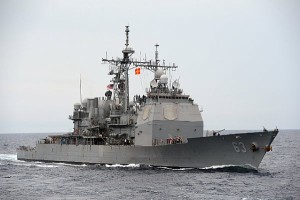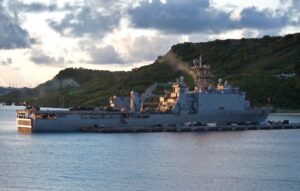The Secretary of the Navy last Friday told a House panel that out of the five cruisers the Navy is seeking to decommission in fiscal year 2024, he would like to add resources to extend three of their lives, but two of them are beyond saving.
The Navy’s fiscal year 2024 30-year shipbuilding plan outlined plans to inactivate the Ticonderoga
-class guided-missile cruisers USS Antietam (CG-54), Leyte Gulf (CG-55), Cowpens (CG-63), Shiloh (CG-67) and Vicksburg (CG-69) two to three years earlier than their expected service lives (ESLs).

(Photo: U.S. Navy)
Secretary Carlos Del Toro told a House Armed Services Committee hearing that the ships are aging out of usefulness, even if they are technically under their ESLs.
“The fact is that ships get old. And once they reach a certain point, even if they’re below their ESLs, they’re not in the correct material condition to be able to continue to operate those ships. We cannot deploy those [Vertical Launch Cells, VLS] cells, for example, if they’re stuck in a maintenance pier, and they can’t be fired from ashore. So the real key to success is trying to get them operationally available to the fleet to fulfill the missions that they have to fulfill,” Del Toro said in response to questioning by Rep. Rob Wittman (R-Va.).
He underscored that of the five cruisers the Navy is seeking to inactivate next year, “there’s nothing more that I would love to do is to invest resources into three of those to actually extend them by one or two deployments. And I think that’s achievable as you and I have spoken about in the past.”
However, Del Toro insisted that both the Vicksburg and the Cowpens “will never see another deployment, regardless of how much money we put into them.”
The secretary said he thinks rather than trying to save CG-63 and 69, “I think it’s a far better strategy to allocate the monies that are dedicated to those ships, and apply them to say, the LSDs, for example, so that we can get the [USS Tortuga (LSD-46)] out of its maintenance availability and operational again, to support the commandant.”
The shipbuilding plan said the service also plans to decommission the USS Germantown (LSD-42) and Gunston Hall (LSD-44) Whidbey Island-class dock landing ships in 2024.
“I think those are the types of solutions that we could work together on in the future in this year’s budget and next year’s budget to get to a better place,” Del Toro said.

However, the secretary repeated Navy leaders’ previous insistence that LSD-42 is also beyond saving (Defense Daily, March 22).
“Her main crane on the Germantown has not operated in six years. We’ve even had the [original equipment manufacturer] over to try to fix the crane, and we can’t get it to work properly. She’s the ship with the oldest, actually, wood deck, which is also deteriorating. It would cost approximately half a billion dollars to replace that deck, replace that crane. And the best that you could do is actually perhaps if you’re lucky, get one additional deployment out of her. I would much rather use those funds on a brand new LPD that could have capabilities that last out 20 plus years, and be far more effective and provide a greater return on investment for the Congress and the American taxpayer,” he said.